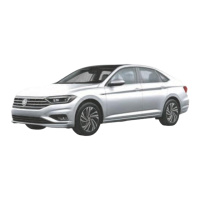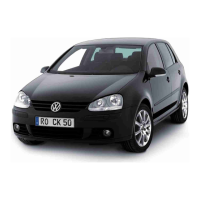to reduce the intake of toxic exhaust gases.
cos in the passenger compartment:
—
Close all the windows and the glass roof.
—
Switch off the air recirculation of the
heating and ventilation system or the air
conditioner.
—
Open all air vents on the instrument
panel.
—
Set the highest fan level of the heating and
ventilation system or the climate control
unit.
The vehicle's gearbox, running gear or electrical
system.
•
Never drive through salt water; salt can cause
corrosion. Immediately rinse any vehicle parts
that have been in contact with salt water with
fresh water.
in contact with salt water.
Engine running-in
With the tailgate open, the height and, if
necessary, the length of the vehicle changes.
Driving on flooded roads
To avoid damage to the vehicle, e.g. when
driving on flooded roads, please note the
following:
—
The water must not exceed the lower edge of
the body → .
—
Advance at pedestrian speed.
—
Never stop the vehicle in the water or drive in
reverse or turn off the engine.
—
Vehicles travelling in the opposite direction form
waves that can raise the water level so high for
the vehicle itself that it is not possible to cross
the water safely.
—
Always switch the Start-Stop system off
manually → page 121 if you are driving through
water.
A new engine must be run-in for the first 1500
kilometres (1000 miles). All moving parts should be
able to be synchronised. During the first hours of
operation, the internal friction of the engine is
much higher than afterwards.
Up to 1000 kilometres (600 miles):
—
Do not accelerate hard.
—
Do not run the engine at more than 2/3 of its
maximum speed.
From 1000 to 1500 kilometres (600 to 1000 mi-
llas):
—
Gradually increase the speed and engine
speed.
The driving style during the first few days
1500 kilometres (1000 miles) also influences the
quality of the engine. It is also advisable to drive at
moderate engine speeds afterwards, especially
when the engine is cold, to reduce engine wear and
increase mileage.
Do not drive at too low a speed. Always downshift
when the engine is not running properly.
The tyres → p. 259 and brake pads
→ p. 112 new ones have to undergo a careful
rotation.
Proper running-in of the engine will increase
its service life and, at the same time, it will
will reduce engine oil consumption.
•
When passing through water, vehicle
components such as the engine, gearbox and
body can be severely damaged.
The vehicle has been manufactured for a particular
country and complies with the type-approval
provisions in force in that country at the time of
manufacture of the vehicle.
If the vehicle is to be used temporarily or for a short
period of time abroad, please observe the relevant
information → page 34.
Use of the vehicle in other
countries and continents
After driving through water, mud, slush, etc., the
braking performance may be reduced and the
braking distance increased because the brake
discs and pads are wet or even frozen in
winter.
•
Use caution when braking to dry the brakes
and free them from ice. In doing so, do not
endanger other road users.
and respect the legal provisions.
•
Avoid braking immediately after
water crossing.

